Introduction to Chicken In A Clay Pot Recipe
Chicken in a clay pot is a dish that combines comfort with tradition. Cooking in clay brings out natural flavors and keeps the meat tender and juicy. The slow heat locks in aroma and gives the dish a rustic touch. This recipe is simple to follow and rewarding in taste. Read on to learn how to prepare, cook, and serve this flavorful chicken dish at home.
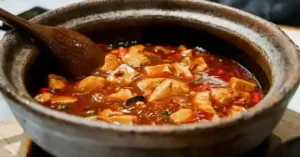
Why Cook Chicken in a Clay Pot?
Cooking chicken in a clay pot is more than just a method—it’s an experience that enhances both flavor and texture. Unlike metal or nonstick cookware, clay distributes heat slowly and evenly. This allows the chicken to cook gently, keeping it moist and tender inside while developing rich, deep flavors.
Another benefit is the natural way clay locks in moisture. You don’t need as much oil or added liquid because the pot itself helps retain juices. The result is chicken that’s juicy, flavorful, and healthier compared to other cooking styles.
Clay also adds a unique earthy taste that you can’t achieve with modern cookware. This is why clay pot cooking is found in many traditional cuisines around the world. From Asian herbal chicken dishes to Mediterranean stews, the technique has been trusted for generations.

Choosing the Right Clay Pot
The success of clay pot chicken often depends on the pot you use. Not all clay pots are the same, and choosing the right one ensures even cooking and authentic flavor.
Types of Clay Pots
- Unglazed clay pots: These are traditional and allow the food to absorb a subtle earthy taste. They need proper soaking before use to prevent cracking.
- Glazed clay pots: Easier to clean and less likely to absorb flavors, but they don’t offer as much of the natural “earthy” flavor.
- Tagines and donabes: Regional variations such as Moroccan tagines or Japanese donabes work beautifully for chicken dishes and add cultural flair.
Size Matters
Choose a pot that matches the amount of food you plan to cook. A medium-sized pot (around 3–4 quarts) is usually perfect for serving a family meal. The pot should be deep enough to layer chicken and vegetables without crowding.
Preparing the Pot Before Use
Clay pots often need to be soaked in water for 15–30 minutes before cooking. This helps prevent cracks and allows the clay to release steam slowly during cooking. If it’s a new pot, check the manufacturer’s instructions on seasoning or curing before the first use.
Heat Considerations
Clay pots are sensitive to sudden temperature changes. Always place the pot in a cold oven or on a low flame and let it heat gradually. Sudden heat can cause cracking. Similarly, avoid placing a hot clay pot directly on a cold surface.
Caring for Your Clay Pot
Wash the pot by hand with warm water only—avoid harsh soaps that can seep into the clay. Let it dry fully before storing, and if it’s unglazed, store it in a dry, airy place to prevent mold.
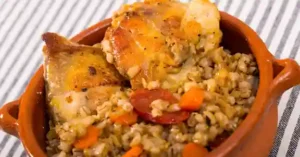
Essential Ingredients for Clay Pot Chicken
The beauty of clay pot chicken lies in its simplicity. With a few basic ingredients, the dish becomes aromatic, juicy, and comforting. Here are the essentials you’ll need:
Chicken
Use bone-in pieces like thighs, drumsticks, or a whole cut-up chicken. Bone-in chicken releases more flavor during slow cooking and stays moist. If you prefer leaner meat, you can use breast pieces, but be careful not to overcook them.
Vegetables
Common choices include onions, carrots, bell peppers, potatoes, and mushrooms. These vegetables absorb the chicken juices, making them tender and flavorful. Root vegetables like potatoes or sweet potatoes work well as they hold up to long cooking times.
Aromatics and Herbs
Garlic, ginger, and onions are classic aromatics that give the dish depth. Fresh herbs such as thyme, rosemary, cilantro, or parsley add fragrance and brightness. Dried spices like paprika, cumin, or coriander can also be added for extra layers of flavor.
Seasonings
Salt and freshly ground black pepper are the foundation. Soy sauce, oyster sauce, or fish sauce can bring a savory, umami touch if you want an Asian twist. A splash of lemon juice or vinegar helps balance richness with a little acidity.
Liquid Base
A small amount of broth, stock, or even water is enough. The clay pot will trap steam, so you don’t need much liquid. For extra richness, you can use coconut milk, wine, or tomato-based sauces depending on the flavor profile you want.
Optional Additions
Rice or grains can be cooked directly with the chicken for a one-pot meal. Dried fruits like apricots, dates, or raisins add sweetness, especially in Mediterranean or Middle Eastern versions. Nuts such as almonds or cashews can give a crunchy finish.
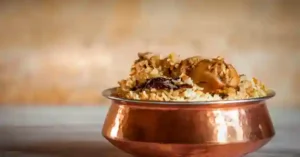
Preparing the Chicken and Vegetables
Proper preparation is the key to getting the best results from your clay pot chicken. Taking a few extra minutes before cooking ensures that the meat stays tender, the vegetables absorb flavor, and everything cooks evenly.
Preparing the Chicken
- Clean and trim: Rinse the chicken pieces under cold water and pat them dry with a paper towel. Trim off excess fat or skin if you prefer a lighter dish.
- Marinate for flavor: A simple marinade of salt, pepper, garlic, and herbs works well. For a deeper taste, let the chicken sit in a mixture of soy sauce, ginger, and a splash of oil for at least 30 minutes or overnight in the fridge.
- Room temperature tip: Bring the chicken to room temperature before cooking. Cold meat added directly to the clay pot can affect even cooking.
Preparing the Vegetables
- Wash thoroughly: Since clay pot cooking involves minimal liquid, clean vegetables well to avoid grit.
- Cut evenly: Chop vegetables into similar sizes so they cook at the same pace. Hard vegetables like carrots or potatoes should be cut smaller, while softer ones like mushrooms can be left larger.
- Pre-cooking option: For root vegetables, a quick parboil or light sauté can reduce cooking time and prevent them from staying too firm.
Layering for Best Results
Place hard vegetables (like carrots and potatoes) at the bottom of the pot. They need the most heat and will also absorb chicken juices as they cook. Arrange the chicken pieces on top, skin side up if you’re using skin-on cuts. This allows the skin to stay crisp while the meat stays moist. Add softer vegetables and herbs last so they don’t overcook.
Flavor Boosting Tips
Tuck garlic cloves, onion slices, or sprigs of herbs between chicken pieces for even seasoning. Drizzle a little oil or butter over the top for a richer finish. If you want a saucier dish, pour a small amount of broth, wine, or coconut milk around the chicken before cooking.
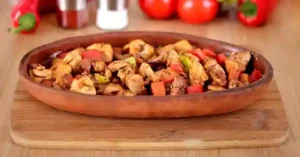
Step-by-Step Cooking Method
Cooking chicken in a clay pot is simple, but it requires patience and the right sequence. Follow these steps to achieve tender, flavorful results.
Prepare the Clay Pot
If using an unglazed pot, soak it in water for 15–30 minutes before cooking. This helps the clay release steam gradually and prevents cracking. Place the pot in a cold oven or on a low flame to avoid sudden temperature changes.
Layer the Ingredients
Start by arranging root vegetables (carrots, potatoes, onions) at the bottom of the pot. These act as a natural base and absorb the juices. Place the marinated chicken pieces on top, skin side up if applicable. Add softer vegetables, herbs, and spices around and over the chicken.
Add Liquid
Pour a small amount of broth, stock, wine, or water into the pot. About ½ to 1 cup is enough—remember, the clay pot will retain moisture. If you prefer a saucier dish, add coconut milk, tomato sauce, or a flavored marinade at this stage.
Begin Cooking
-
Cover the clay pot with its lid.
- If using an oven: place the pot in a cold oven, then set the temperature to 350°F (175°C). Cook for 1–1.5 hours depending on the size of the chicken pieces.
- If using a stovetop: start with low heat and allow the pot to warm gradually, then let the chicken cook gently until tender.
Check for Doneness
The chicken is done when it reaches an internal temperature of 165°F (74°C). Vegetables should be fork-tender and infused with the chicken’s juices.
Finishing Touches
Remove the lid in the last 10–15 minutes of cooking if you want the top of the chicken to brown slightly. Garnish with fresh herbs like parsley or cilantro before serving.
Rest Before Serving
Allow the dish to rest for about 5 minutes after cooking. This helps the juices redistribute, making the chicken even more succulent.
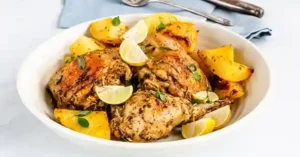
Flavor Variations to Try
One of the best things about clay pot chicken is its versatility. The method stays the same, but you can adjust herbs, spices, and sauces to create completely different versions of the dish. Here are some flavor variations worth trying:
Classic Herb and Garlic
Use fresh rosemary, thyme, and sage with plenty of garlic. A splash of olive oil and a squeeze of lemon bring out bright, rustic flavors. Perfect if you want a simple, homestyle taste.
Asian-Inspired Soy and Ginger
Marinate the chicken in soy sauce, ginger, garlic, and sesame oil. Add shiitake mushrooms, bok choy, and green onions for a complete meal. A drizzle of oyster sauce or a hint of star anise adds authentic depth.
Mediterranean Style
Season with paprika, cumin, coriander, and oregano. Add tomatoes, olives, and bell peppers for color and flavor. Finish with a drizzle of olive oil and a sprinkle of fresh parsley.
Spicy Chili and Lime
Use chili flakes, fresh chilies, or a chili paste for heat. Add lime juice and zest before cooking for a zesty kick. Balance the spice with a little honey or brown sugar.
Coconut Curry Twist
Combine curry powder or paste with coconut milk for a creamy base. Add carrots, potatoes, and green beans for a hearty meal. Garnish with cilantro for freshness.
Sweet and Savory Fusion
Add dried fruits like apricots, raisins, or dates along with almonds or cashews. A touch of cinnamon or nutmeg blends well with the natural sweetness. This style pairs beautifully with rice or couscous.
Smoky Barbecue Style
Coat chicken with a mix of smoked paprika, garlic powder, and brown sugar. Add a bit of barbecue sauce or tomato paste for a rich glaze. Best served with cornbread or roasted vegetables.

Serving Suggestions
Clay pot chicken is hearty and versatile, making it easy to serve in different ways. How you pair it can transform the meal from a rustic family dinner to an elegant centerpiece.
With Rice or Grains
Steamed white rice or jasmine rice soaks up the flavorful juices beautifully. For a nuttier option, try brown rice, quinoa, or couscous. In Mediterranean or Middle Eastern versions, serve with bulgur wheat or pearl barley.
With Bread
Crusty bread, baguettes, or naan are perfect for dipping into the rich sauce. Flatbreads make a great companion if you’ve used spiced or curry-style seasoning.
As a Complete One-Pot Meal
If you’ve layered vegetables and grains in the clay pot, it can be served directly as a self-contained meal. Garnish with fresh herbs or a squeeze of lemon juice just before serving for added freshness.
Side Dishes to Complement
- Light salads: A crisp green salad or cucumber salad balances the richness.
- Roasted or steamed vegetables: Broccoli, asparagus, or green beans work well.
- Pickles or relishes: Add tang and contrast, especially with spicy or savory versions.
Presentation Tips
Serve straight from the clay pot for a rustic, homely touch—it keeps the food warm and adds to the dining experience. For a more formal setting, transfer the chicken and vegetables to a serving platter and spoon the juices over the top.
Pairing with Drinks
A light white wine or herbal tea complements herbal and citrus-based variations. For spiced versions, pair with chilled beer or sparkling water with lime.
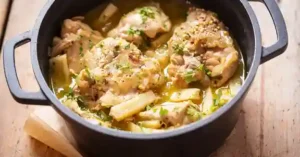
Tips for Perfect Results Every Time
Cooking chicken in a clay pot is straightforward, but a few careful steps can make the difference between a good meal and an outstanding one. Follow these tips to ensure consistent success:
Avoid Sudden Temperature Changes
Always start with a cold oven or low flame and let the clay pot heat up gradually. Rapid temperature shifts can crack the pot. After cooking, place the hot pot on a wooden board or cloth instead of a cold countertop.
Don’t Overfill the Pot
Leave enough space for steam to circulate inside. Overcrowding can lead to uneven cooking and soggy textures. Use a pot size that comfortably fits the ingredients rather than forcing too much in.
Use Minimal Liquid
The clay pot naturally retains moisture, so avoid adding too much broth or water. A little goes a long way. If you prefer a saucier dish, add liquid gradually rather than all at once.
Marinate for Maximum Flavor
Even a simple 30-minute marinade enhances the taste. For deeper flavors, marinate overnight in the fridge with herbs, spices, or soy-based sauces.
Layer Ingredients Properly
Hard vegetables like carrots and potatoes go at the bottom, while chicken and softer veggies sit on top. This ensures everything cooks evenly and flavors blend well.
Check Doneness Without Lifting the Lid Too Often
Every time you open the pot, steam escapes and cooking slows down. Wait until the last part of the cooking time before checking if the chicken is fully cooked.
Rest Before Serving
Let the chicken sit for 5–10 minutes after removing it from the oven. This helps the juices redistribute and makes the meat tender.
Handle Leftovers Carefully
Store leftovers in an airtight container in the fridge for up to 3 days. Reheat slowly to prevent the chicken from drying out—using the clay pot again works best.
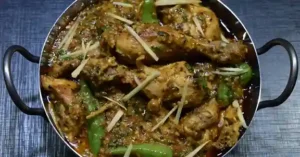
Conclusion
Cooking chicken in a clay pot is a simple way to turn everyday ingredients into a flavorful, comforting dish. The slow, gentle heat of the clay brings out natural tastes, keeps the meat tender, and creates a rustic dining experience. With the right preparation, seasoning, and serving ideas, you can enjoy a meal that feels both traditional and special. Try this recipe at home, and you’ll discover why clay pot cooking has been cherished across cultures for generations.
FAQS
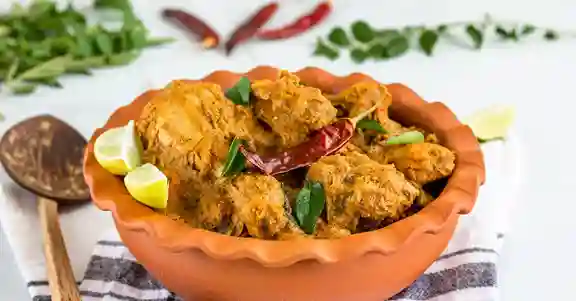
Chicken In A Clay Pot Recipe
Ingredients
Method
- Completely submerge the top and bottom in water and soak for 30 minutes prior to cooking.
- Wash and dry chicken. Allow to come to room temperature (or about 70 degrees) before placing in oven, about 1 1/2 hours.
- Put veggies and herbs in baker and place chicken on top. Sprinkle with salt & pepper.
- Place baker in a cold oven and then turn temp. to 450 degrees. Bake covered for 1 1/2 hours or until skin is browned and chicken is done.
- Let stand for 15 minutes before carving.